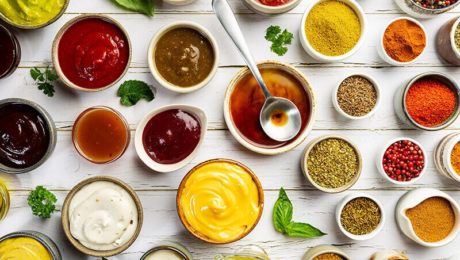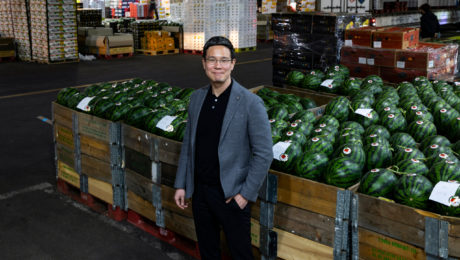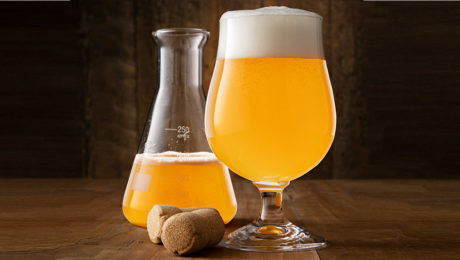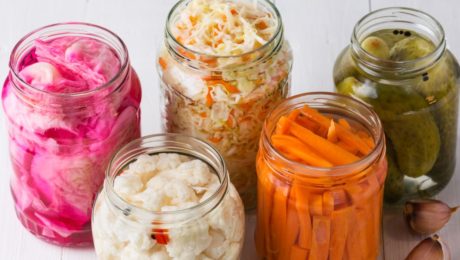“Next Level Fermentation”
“Fermented and Flourishing” is what Whole Foods Market calls the growing world of fermented condiments. The retailer’s Trends Council released their first-ever summer condiments trends predictions.
“These days, fermented foods are an unstoppable force charging through aisle after aisle with a full head of steam. Condiments are no exception,” reads the press release. “We’re seeing tangy fermented ingredients adding flair to vinaigrettes, hot sauces, honeys and mayos. With flavor boosts like miso, kimchi and fermented garlic, these products exponentially expand the flavor possibilities of every summer soirée.”
Sales for the condiment, marinade and dressing categories are expected to hit $2.9 billion by 2024, according to market research firm Mintel.
Whole Foods’ list highlighted emerging and established fermented condiments: Lucky Foods Seoul Kimchi Mayo, Cleveland Kitchen’s line of fermented dressings and marinades, California Olive Ranch Carrot Miso Vinaigrette, Firefly Kitchens Kimchi Hot Sauce and Ninja Squirrel Coconut Sriracha Hot Sauce.
Read more (Whole Foods Market)
- Published in Business, Food & Flavor
Sriracha Shortage
A failed spring chile harvest has left sriracha brands in the lurch. Sriracha – a fermented condiment made with peppers, vinegars, salt, sugar and garlic – can’t be made without the iconic red jalapeño chiles.
Huy Fong Foods, based in Irwindale, Calif., produces one of the most popular sriracha brands. They typically use 100 million pounds of chiles a year to make sriracha, chili garlic sauce and sambal oelek. But drought in Mexico has caused an “unprecedented shortage” and left store shelves consistently empty of the famous sriracha brand.
The chile shortage is hurting other companies, too. Though Mother-in-Law’s Kimchi uses the chiles in their products, they haven’t felt the crunch so far. “It hasn’t trickled down to a smaller supplier like me yet, but I think it just means that it’s coming,” said Lauryn Chun, founder.
Read more (The New York Times)
- Published in Business
Championing Indigenous Brewers
The headline says it all: “The Country’s First Native American Woman-Owned Brewery in the U.S. Doesn’t Want to Be Its Last.”
Co-founders Shyla Sheppard (who has heritage from the Three Affiliated Tribes – Mandan, Hidatsa and Arikara – of North Dakota) and her business partner and wife, Dr. Missy Begay (Diné heritage) founded Bow & Arrow Brewing Co. in 2016. The brewery has become known for wild and sour beers made with cultivated yeast. They forage for neomexicanus hops, a species found in New Mexico. Local and indigenious ingredients – like blue corn, sumac, prickly pear and juniper – are used in a new line of hard seltzers.
Bow & Arrow began a unique initiative on October 11, 2021, Indigenous Peoples’ Day. The brewery launched Native Land. They provided an IPA recipe to breweries across the U.S. to create a beer for a common mission: “to acknowledge the contributions and history of Native American people in the United States.” Participating breweries were given a can design template, which included space to acknowledge the tribal land where the brewery is located.
The campaign was so popular – 53 breweries in 24 states and one Canadian province brewed Native Land beer – that they extended the deadline for the project to September 2022. The beers are “vehicles for activism,” with a portion of proceeds going to a Native American-operated nonprofit of the brewer’s choice.
“We’re reclaiming our history and narrative. I think the contributions that Native people have had to agriculture have been erased or dismissed. It’s important to share that story to non-Native people, but also to other Native folks,” she says. “I think fostering that appreciation and connection to our history brings about healthier Native communities.”
Bow & Arrow is one of only a small number of Native-owned breweries in the U.S. – but Sheppard and Begay hope that will change and, one day, there will be more. Sheppard adds: “Having done what we’ve done — in what I hope is a respectful way of incorporating our culture and background — I think it’s inspiring other brewers.”
Read more (Eater)
- Published in Business, Food & Flavor
“Fermentation…a form of magic”
“Fermentation is hope for trans folks. If people can conceptualize cucumbers becoming pickles, then they can grasp a trans person’s name change. If the possibility of Camembert, Parmesan, and ricotta exist within milk, then think of all the possible genders to choose from!” reads an article in Bon Appetit.
The magazine published an article by transgender cheesemaker-turned-journlaist H. Conley who, while immersed in the world of cheesemaking and the fermentation of milk into cheese, realized they were trans. The article’s accompanying illustration (pictured) by artist Jasjyot Singh Hans is called “Trans-Fermentation.”
Conley writes: “I didn’t see trans fermenters as a pattern until June Henry Hyde, a trans 18-year-old from Kansas, told me her plans to start a pickling business with her nonbinary partner. She showed me the self-administered tattoos on her forearm: a pickled pepper jar next to a star-topped wand.”
“I consider fermentation to be a form of magic,” she told me. For her, transition is magic as well. It takes magic to manifest desired realities. “But there’s this other layer of people who are really averse to fermented foods, like ‘It’s different, it’s undergone this transformation that’s made it less desirable,’” she added. The otherworldly SCOBY in kombucha, the stinging fragrance of kimchi, the very concept of eating mold makes some resistant to giving fermented foods a chance. “It’s seen as an acquired taste in some cases, which resonates with me a lot as a trans person.”
Read more (Bon Appetit)
- Published in Food & Flavor
Beauty Embraces Bacteria
Beauty brands continue to capitalize on a trend: putting prebiotics, probiotics and postbiotics into skin-care products. This “wave of new products” that tout -biotics is filling the cosmetic aisle, according to The New York Times.
“It’s like ‘Star Wars’ happening on the surface of skin,” says Dahlia Devkota, founder of the Los Angeles-based skin-care brand Editrix. “‘Good’ and ‘bad’ bacteria both excrete postbiotics, which are their weapons of war. The goal is a balance of both with no one species taking over.”
Devkota adds that she finds skin care products with -biotics are gentler on the skin. Many traditional skin-care brands strip the skin of natural oils, “weaken(ing) the skin barrier.”
Some brands are experimenting with using fermented ingredients in their skin care products. Venn, another Los Angeles-based skin-care brand, has a scientific advisory board that has spent decades studying the microbiome. Venn’s Synbiotic Defense Mist face spray uses water with probiotic ferments.
“Because fermentation makes the molecules smaller, the product can penetrate the skin surface more deeply,” says Jeff Rosevear, the head of skin-care research and development for new brands at Unilever. The company’s new line, Ferver, has a serum made with fermented collagen.
Read more (The New York Times)
Trying to Transform the Global Food Trade
The worldwide fresh produce market has long been plagued by mistrust. The industry lacks transparency, a major issue when dealing with perishable goods. The window for transactions is small. There’s no official network, so sellers have a variety of customers, and buyers use many different suppliers.
Enter Tridge (stands for Transaction Bridge), a Korean startup working directly with farmers and grocery stores. Tridge tracks the real-time price, quality and volume of produce. Tridge aims to be a transparent middleman, quickly connecting buyers and sellers when there’s a supply chain interruption.
Hoshik Shin, founder and chief executive of Tridge, says it is a one-stop shop. Farmers can use the data to see which products are more popular, and buyers can check for prices and availability and suppliers can diversify their sales channels.
“Mr. Shin’s ambition is to aggregate that data into a massive, moving, real-time image of fresh produce on the planet,” the article reads. “Anyone can subscribe to Tridge’s intelligence platform and watch the world grow, harvest, pack and ship everything from Indonesian mangosteens to American lemons.”
Read more (The New York Times)
- Published in Business
Yogurt Makers Await FDA Response
The FDA has issued a response – or non-response – to concerns from the International Dairy Foods Association (IDFA).
Last July, the FDA issued a federal, legal definition of yogurt. The new rule upset the IDFA. The association, which represents the nation’s dairy industry, said the FDA’s rule is so outdated and out-of-touch with yogurt makers that popular products could be removed from grocery store shelves. The IDFA objected to the FDA’s rule and submitted an appeal in July 2021 to modernize the yogurt standard of identity (SOI). In December, after not receiving a response, IDFA sent a letter to the FDA commissioner, reiterating the request.
FDA recently issued a “notice of stay” to the IDFA, effectively telling them to keep waiting for a final ruling.
“Yogurt makers have been waiting 40 years for the FDA to update and modernize the yogurt standard of identity,” said Michael Dykes, president and CEO of the IDFA. “Today, the FDA issued a notice telling us to keep waiting — and threw in a whole lot of uncertainty, to boot.”
Adds an IDFA press release: “While a stay is helpful at this stage, IDFA’s efforts to reform the yogurt SOI will continue into an inexplicable fifth decade.”
The FDA first issued a definition of yogurt in 1981. The IDFA has requested a modernized version for decades.
“IDFA remains deeply disappointed in the FDA process that led to the yogurt SOI final rule,” Dykes continues. “After 40 years since FDA first issued standards for yogurt, IDFA and our yogurt members are back to where we started several decades ago, beseeching the FDA to work with yogurt makers to make commonsense updates to a category that has been waiting more than four decades for modernization. Without standards that have been modernized, manufacturers are unable to meet consumer demands for innovative and nutritious yogurt products. With many significant provisions stayed, IDFA will continue to work on the yogurt SOI with an aim to ensure FDA continues to move forward in responding appropriately to IDFA’s objections in a timely manner.”
Read more (IDFA)
- Published in Business
Mixed Culture Beer Fermentation
Just because you’ve pitched an exotic fermenting agent into your beer doesn’t mean the hard work is done. Mixed-culture fermentations are becoming increasingly popular choices for brewers looking to add complexity to their beers. But, as an article in Craft Beer & Brewing details, using a mixed array of yeasts and bacteria requires greater attention to the fermentation process.
“Just because it’s a wild beer doesn’t mean that you can be careless,” says Patrick Chavanelle, R&D brewer at Allagash in Portland, Maine. “Be as meticulous when crafting a mixed-fermentation beer as you would when brewing a beautifully crisp lager.”
Mixed fermentation uses multiple microorganisms as fermenting agents. The most common are yeasts Saccharomyces (known as brewer’s yeast) and Brettanomyces, and the bacteria Lactobacillus and Pediococcus.
The article advises brewers to: embrace uncertainty, focus on pitch rate, pay attention to choice of fermentor, research the yeast or bacteria used and consider post-fermentation doctoring.
Read more (Craft Beer & Brewing)
- Published in Food & Flavor
Making Mead
Mead appealed to David Lane because of the fermentation challenge: it’s hard to make a bad wine, but easy to make a bad mead.
“Honey sometimes needs various chemical nudges,” he said. “It’s a big puzzle figuring out how to get the chemistry just right for each varietal.”
His Oregon-based brand, Wild Nectar Mead, is made with honey from local honeybees. Interacting with their beekeepers made Lane even more passionate about mead. He learned about the dangers of honeybee extinction and the importance of local pollinators. He calls it his “bee-cause.”
Each mead flavor reflects the essence of a variety of honey, such as basswood, clover or wildflower. Lane says he loves these flavor differences.
Lane also has taken a different approach to production. Many purists believe a good mead needs months-long fermentation. Lane has tinkered with a process that takes only a month.
“(Mead) has a long history, but then it fell out of favor with history,” Lane said. “So it feels like a comeback drink to a lot of people.” Read more (auburnpub.com)
- Published in Food & Flavor
Fermented Foods and Running
Fermented foods continue to top nutritionists’ lists as a key healthy and functional component in the ideal human diet. In a new article in Runner’s World, a registered dietician recommends runners eat fermented foods to meet nutrition needs, improve their health and better support their training.
The author lists four reasons to eat fermented foods: improve the gut microbiome, add a nutritional upgrade, aid digestion and improve protein intake.
“Recent research even suggests that the makeup of our microbiome may also play a role in how our muscles adapt and develop in response to exercise. And fertilizing your gut with more desirable bacteria via fermented foods may payoff with better digestive functioning during periods of hard training and throughout long races (read: fewer sprints to the nearest port-a-potty),” the article reads. “To date, the literature suggests that probiotic foods (like fermented foods) are still the preferred method of obtaining probiotics rather than relying on supplements.”
Read more (Runner’s World)
- Published in Health










